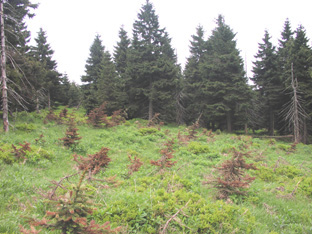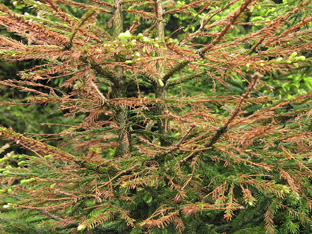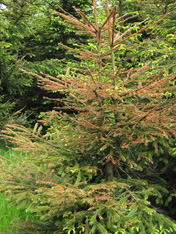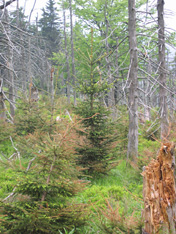Contemporary damage of forest stands in the Orlicke hory Mountains
Frantisek Sach1, Daniela Fottova2, Vratislav Balcar1, Vladimir Cernohous1, Dusan Kacalek1 and Vaclav Narovec1




Summary of paper
A severe damage of young Norway spruce forest stands of a great extent, mainly higher than 800 m a.s.l., appeared in the SE part of the Orlicke hory Mountains in spring 1999. The Norway spruce needles are reddish (rusty) and fall off from the last-year or older twigs at the main ridge of the Orlicke hory Mountains. Deficiency disease has been observed on needles of blue spruce at summit localities (brownish to reddish coloration of needles with transition zones into violet coloration) and a mass dying of of European birch. The damage and dying last-year twigs of Norway spruce is the most severe thing. Dying is in progress not only at summit localities, but at lower altitudes as well (at about 800 m a.s.l.). It gives serious concern about the future development of forest in the Orlicke hory Mountains. Damage of forest stands has been probably caused by complex circumstances, in which air pollution obviously plays an important role.
The authors, after extensive analysis, arrived at the following conclusions:
- In spite of decrease of SO2 emission (and thus also its concentration in the air), deposition of sulfur is still at a high level and it can participate in damaging the health conditions of forest ecosystems (mainly Norway spruce) of the Orlicke hory Mountains. Content of SO2 was accused of damages on forest stands in the Orlicke hory Mountains in the eighties.
- Nitrogen depositions (ammonium and nitrate ions) exceed the critical limits many times and by cooperation of frequent and long dry periods in the vegetative season they can create serious threat to the spruce ecosystems.
- High levels of air pollution caused by fluorine, chlorine and ozone are also the threat.
- The year 1998 is a warning season in which air pollution caused by NO3 (depositions on a free area and below the forest stand) has been considerably increased in the Orlicke hory Mountains. A considerable increase has also been recorded in air pollution caused by sulfur, fluorine, chlorine caught by the tree crowns, and also the concentration of ozone in the air.
Orig. citation (in Czech):
Sach, F., Fottova, D., Balcar, V., Cernohous, V., Kacalek, V. and Narovec, V. 1999: Mohou imise i dnes skodit lesnim porostum v Orlickych horach? Lesnicka prace, 78, (10): p. 452 - 455.